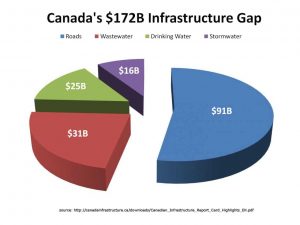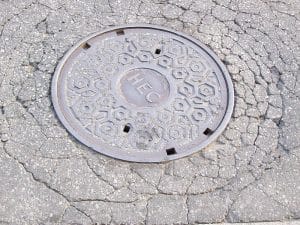Prioritizing Asset Management in Ontario, Canada
 Each municipality and utility is responsible for making sure that its assets, including water, wastewater, and/or stormwater systems, stay in good working order, regardless of the age of its components or the availability of additional funds. This requirement makes properly maintaining and monitoring assets paramount. With limited resources, an asset management plan can help municipalities and utilities maximize the value of their capital as well as their operations and maintenance dollars. Asset management is a scalable approach that can be utilized by all types of systems, of any size.
Each municipality and utility is responsible for making sure that its assets, including water, wastewater, and/or stormwater systems, stay in good working order, regardless of the age of its components or the availability of additional funds. This requirement makes properly maintaining and monitoring assets paramount. With limited resources, an asset management plan can help municipalities and utilities maximize the value of their capital as well as their operations and maintenance dollars. Asset management is a scalable approach that can be utilized by all types of systems, of any size.
A Nation’s Infrastructure in Crisis
 The 2016 Canadian Infrastructure Report card states that over one-third of Canada’s municipal infrastructure is in fair, poor, or very poor condition, and at risk of rapid decline. With the support of the federal government, Ontario municipalities are embarking on an unprecedented renewal phase of these critical assets, recognizing that Canadians rely on this infrastructure for their quality of life. The Ministry of Infrastructure released its guide to asset management planning and has made funding available to small, rural, and northern municipalities in Ontario to develop and implement asset management plans.
The 2016 Canadian Infrastructure Report card states that over one-third of Canada’s municipal infrastructure is in fair, poor, or very poor condition, and at risk of rapid decline. With the support of the federal government, Ontario municipalities are embarking on an unprecedented renewal phase of these critical assets, recognizing that Canadians rely on this infrastructure for their quality of life. The Ministry of Infrastructure released its guide to asset management planning and has made funding available to small, rural, and northern municipalities in Ontario to develop and implement asset management plans.
In addition, as part of the New Building Canada Plan, the renewed federal Gas Tax Fund (GTF) was announced in the 2013 Economic Action Plan as a long-term, stable source of funding for municipal infrastructure. Implemented as a means of addressing the infrastructure funding gap, the GTF will provide $10.4 billion to Canada’s municipalities through 2018. Because Canada recognizes the criticality of an up-to-date asset management plan, the renewed GTF prioritizes long-term capital planning and asset management. The Province of Ontario has moved a step further, actually requiring each municipality to build and implement an asset management plan.
Setting Rates Based on Sound Financial Planning
 It is apparent that financial planning for municipalities and utilities must be based on sound asset condition projections from an engineering and operations perspective – not just financial assumptions. Customers are often adamantly against rate and tax increases; however, these sometimes-unavoidable increases are easier for customers to understand — and accept — when they are backed up with clear data showing exactly what system improvements are needed and why. There are many costs associated with municipality and utility operations and maintenance. One of these is the cost of asset ownership, a cost element not currently present in the audited financial statements of many municipalities and utilities. An asset management approach can aid municipalities and utilities in understanding the true costs associated with ownership and operation along with complying with government regulations.
It is apparent that financial planning for municipalities and utilities must be based on sound asset condition projections from an engineering and operations perspective – not just financial assumptions. Customers are often adamantly against rate and tax increases; however, these sometimes-unavoidable increases are easier for customers to understand — and accept — when they are backed up with clear data showing exactly what system improvements are needed and why. There are many costs associated with municipality and utility operations and maintenance. One of these is the cost of asset ownership, a cost element not currently present in the audited financial statements of many municipalities and utilities. An asset management approach can aid municipalities and utilities in understanding the true costs associated with ownership and operation along with complying with government regulations.
Budgeting Focused on Critical Activities
An asset management program helps to identify exactly what maintenance and repair work is necessary, eliminating guesswork. Targeting municipalities’ admittedly limited funds to pipes, roads, structures, and other critical assets that are most in need of rehabilitation or replacement, rather than randomly selected assets, allows municipalities to stretch their infrastructure dollars and to proactively avoid critical asset failure. This methodology also creates the opportunity to utilize the savings to accomplish other system goals. Examples of the opportunities are as follows:
Meeting Consumer Demands with a Focus on System Sustainability
 Finding and detecting failures such as leaks in the system can prevent water loss as well as reduce energy consumption of treating and pumping water that never makes it to the customer. Reducing water loss eases demand on water systems, allowing for smaller, lower cost infrastructure and reducing water shortages. Also, reduced energy consumption allows systems to run greener and more cost-effectively. Thoughtful investments in critical assets can extend the life of those assets by several years, providing a significant return on investment. And by maintaining critical assets rather than prematurely replacing them, customers enjoy better, more consistent service for lower cost.
Finding and detecting failures such as leaks in the system can prevent water loss as well as reduce energy consumption of treating and pumping water that never makes it to the customer. Reducing water loss eases demand on water systems, allowing for smaller, lower cost infrastructure and reducing water shortages. Also, reduced energy consumption allows systems to run greener and more cost-effectively. Thoughtful investments in critical assets can extend the life of those assets by several years, providing a significant return on investment. And by maintaining critical assets rather than prematurely replacing them, customers enjoy better, more consistent service for lower cost.
Better Data Management
Through accurate data collection, municipalities and utilities can expect significant benefits from an asset management approach. Collecting, sharing, and analyzing data about a distribution system helps utilities make better informed decisions on maintaining, rehabilitating, and replacing aging assets. Utilities can also use this data to better communicate with their governing bodies and the public. In addition, asset management helps communicate information across departments and coordinate planning and decision-making related to infrastructure needs and improvement plans.
In Conclusion
There is a difference between a cost and an investment, and asset management is a true investment in municipalities’ and utilities’ future. It helps systems to provide better service at a lower cost with reduced risk and improved financial planning options. Asset management results in better decision-making and supports the long-term success of a municipality or utility’s mission, goals, and objectives. With Ontario’s groundbreaking legislation, municipalities and utilities now have an unprecedented opportunity to improve and rehabilitate crucial assets with the full support of local government.

Rhonda E. Harris, P.E., MBA, WEF Fellow, IAM Certified
Vice President and Global Director of Asset Management
Rhonda has over 40 years of experience in managing and administering a variety of facilities and programs in the water environment industry. She has been actively involved on an international level in addressing issues of water and sanitation through leadership and participation in the top water professional organizations in the world. As a Past President of WEF, an elected member of The International Water Academy (TIWA), an Honorary Member of the American Water Works Association (AWWA), a member of the Executive Committees of LakeNet and The Inter-American Water Resource Network (IWRN), and participant in a number of additional non-governmental organizations (NGOs) in the water sector, she has worked for change and improvement of the global water environment for many years. She holds a B.S. degree in Civil Engineering from the University of Texas at Arlington, and an M.B.A. degree in Business Administration from Southern Methodist University.
Rhonda can be reached at 214-697-0109 or rharris@tataandhoward.com.
